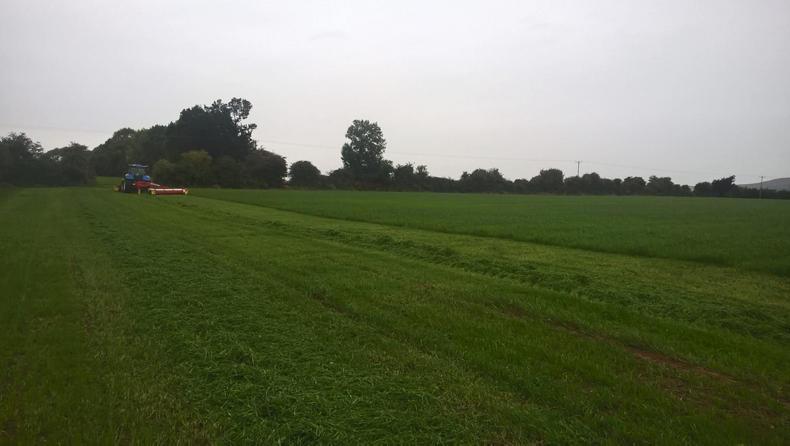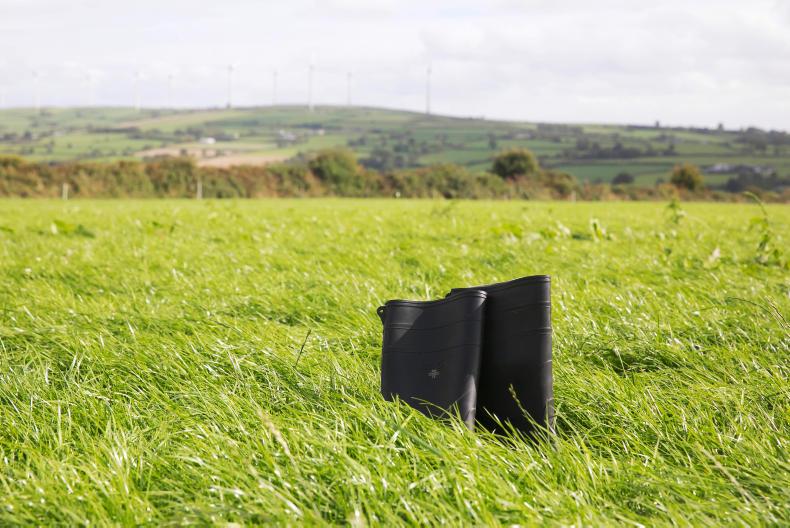Average grass growth rates for the past week are still only OK at around 55/kg. But rainfall is back to normal and soil temperatures are between 1°C and 1.5°C higher than normal so we should see growth rates increase over the coming weeks. Even if they hold as they are, it will be an increase in real terms as we normally see grass growth rates tail off in late September.
A lot of the third-cut silage fields are beginning to get cut. The amount of grass on these fields is very variable. The best crops have over 4t/ha DM while poorer crops that were starved of rain for longer are struggling to have more than 2t/ha DM. In round bale terms, this is between 7 and 3.5 bales/acre. Where there are lighter crops, it’s a real trade-off between getting bulk, and getting grass back for the rest of the year. It depends on the situation on each farm, but lower-stocked farms can probably afford to let it build up for longer, while higher stocked farms will have to cut soon.
The forecast for the coming week is mixed enough so the chances to cut and get a wilt will be scarce, but there might be windows of opportunity.
On the fodder crop side, it’s a mixed bag. Some fields of hybrid rape are flying it, while more are not going great. Fields that weren’t rolled well after sowing are really struggling. At this stage, there isn’t a lot that can be done. Once the fertiliser has been spread, all you need to do is watch for pests and look at it grow. Some fields of Westerwolds are getting near ready for cutting.
Athy, Co Kildare: Growing a fodder crop on a tillage farm
Michael O’Brien’s redstart now stands at 45cm in height and the majority of the volunteer barley plants have been killed. A local dairy farmer has committed to buying the crop. While no price is set yet, the crop cost €150/ac to establish. The dairy farmer intends on erecting temporary fences, splitting the field into paddocks and strip grazing the crop. He will place a bale of silage in each paddock to feed in addition to the redstart. Under the agreement, the field will be cleared by 7 March 2019.
Rathcormac Co Cork: third-cut silage

Jack Kearney has decided to cut his fields of third-cut silage near Fermoy. There is a cover of between 2,000kg/ha and 2,500kg/ha on it but Jack says the main reason for cutting now is that in-calf heifers are running out of grass and will need silage soon unless they are given more area. He would prefer to let it grow a little longer but says there’s no point in making silage just to feed silage. He will send over 10 heifers to graze the headlands after cutting the silage. He was hitching on the mower at time of going to press on Wednesday.
Tullamore Farm, Co Offaly: fodder crop

The Redstart and Interval crops of hybrid rape are flying it on Tullamore. It’s hard to judge the yield but by eyeballing it we think there is a cover of around 1,600kg/ha on it now. It has thickened up very well over the past week. Farm manager Shaun Diver was thinking of topping it up with nitrogen but won’t do it now. The bigger problem is that grass growth has slowed and there are no more surplus bales going to be made so he will have to move bales from a stack in the yard to place in the field.
Midlands: buying third-cut silage

This field of grass is flying it. It’s a third cut of silage on hungry enough land near Mullingar but the weather over the last few weeks has really suited it. The plan all along was to cut the crop in late September and draw the bales down to the dairy farm in Kilkenny. There is currently a cover of about 2,100kg on it so there could be over 3.5tDM/ha by the time it is cut, which should yield around six or seven bales/acre.
Doneraile, Co Cork: Growing grass on a tillage farm

John Stokes cut some of his Westerwolds grass on Tuesday evening and plans to bale it on Thursday. It tested high in nitrate but the sugars were also high so he is hoping that the wilt will help preservation. The field was cut about three weeks earlier than planned as it was starting to go to seed. He doesn’t want any seeds falling on his tillage fields. The bales are already sold to neighbours for a price yet to be agreed but in the region of €30/bale. He will spread some nitrogen and plans to cut again in about five weeks’ time.
Bunclody, Co Wexford: Spreading more fertiliser on a livestock farm

John Doyle’s farm near Bunclody continues to grow very well. John decided that he was going to grow his own way out of the fodder deficit and it seems to be working. Grass is growing at 70kg/day again this week. He is going to top up the whole grazing block with three-quarters of a bag/acre of CAN. That will be the last round for the year. He hopes to cut the silage on the pictured field after the National Ploughing Championships. He is cutting more silage next week and if he gets 100 bales he should be OK for the winter.
Average grass growth rates for the past week are still only OK at around 55/kg. But rainfall is back to normal and soil temperatures are between 1°C and 1.5°C higher than normal so we should see growth rates increase over the coming weeks. Even if they hold as they are, it will be an increase in real terms as we normally see grass growth rates tail off in late September.
A lot of the third-cut silage fields are beginning to get cut. The amount of grass on these fields is very variable. The best crops have over 4t/ha DM while poorer crops that were starved of rain for longer are struggling to have more than 2t/ha DM. In round bale terms, this is between 7 and 3.5 bales/acre. Where there are lighter crops, it’s a real trade-off between getting bulk, and getting grass back for the rest of the year. It depends on the situation on each farm, but lower-stocked farms can probably afford to let it build up for longer, while higher stocked farms will have to cut soon.
The forecast for the coming week is mixed enough so the chances to cut and get a wilt will be scarce, but there might be windows of opportunity.
On the fodder crop side, it’s a mixed bag. Some fields of hybrid rape are flying it, while more are not going great. Fields that weren’t rolled well after sowing are really struggling. At this stage, there isn’t a lot that can be done. Once the fertiliser has been spread, all you need to do is watch for pests and look at it grow. Some fields of Westerwolds are getting near ready for cutting.
Athy, Co Kildare: Growing a fodder crop on a tillage farm
Michael O’Brien’s redstart now stands at 45cm in height and the majority of the volunteer barley plants have been killed. A local dairy farmer has committed to buying the crop. While no price is set yet, the crop cost €150/ac to establish. The dairy farmer intends on erecting temporary fences, splitting the field into paddocks and strip grazing the crop. He will place a bale of silage in each paddock to feed in addition to the redstart. Under the agreement, the field will be cleared by 7 March 2019.
Rathcormac Co Cork: third-cut silage

Jack Kearney has decided to cut his fields of third-cut silage near Fermoy. There is a cover of between 2,000kg/ha and 2,500kg/ha on it but Jack says the main reason for cutting now is that in-calf heifers are running out of grass and will need silage soon unless they are given more area. He would prefer to let it grow a little longer but says there’s no point in making silage just to feed silage. He will send over 10 heifers to graze the headlands after cutting the silage. He was hitching on the mower at time of going to press on Wednesday.
Tullamore Farm, Co Offaly: fodder crop

The Redstart and Interval crops of hybrid rape are flying it on Tullamore. It’s hard to judge the yield but by eyeballing it we think there is a cover of around 1,600kg/ha on it now. It has thickened up very well over the past week. Farm manager Shaun Diver was thinking of topping it up with nitrogen but won’t do it now. The bigger problem is that grass growth has slowed and there are no more surplus bales going to be made so he will have to move bales from a stack in the yard to place in the field.
Midlands: buying third-cut silage

This field of grass is flying it. It’s a third cut of silage on hungry enough land near Mullingar but the weather over the last few weeks has really suited it. The plan all along was to cut the crop in late September and draw the bales down to the dairy farm in Kilkenny. There is currently a cover of about 2,100kg on it so there could be over 3.5tDM/ha by the time it is cut, which should yield around six or seven bales/acre.
Doneraile, Co Cork: Growing grass on a tillage farm

John Stokes cut some of his Westerwolds grass on Tuesday evening and plans to bale it on Thursday. It tested high in nitrate but the sugars were also high so he is hoping that the wilt will help preservation. The field was cut about three weeks earlier than planned as it was starting to go to seed. He doesn’t want any seeds falling on his tillage fields. The bales are already sold to neighbours for a price yet to be agreed but in the region of €30/bale. He will spread some nitrogen and plans to cut again in about five weeks’ time.
Bunclody, Co Wexford: Spreading more fertiliser on a livestock farm

John Doyle’s farm near Bunclody continues to grow very well. John decided that he was going to grow his own way out of the fodder deficit and it seems to be working. Grass is growing at 70kg/day again this week. He is going to top up the whole grazing block with three-quarters of a bag/acre of CAN. That will be the last round for the year. He hopes to cut the silage on the pictured field after the National Ploughing Championships. He is cutting more silage next week and if he gets 100 bales he should be OK for the winter.











 This is a subscriber-only article
This is a subscriber-only article










SHARING OPTIONS: